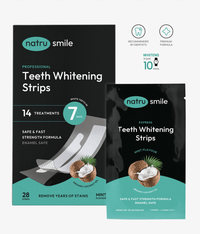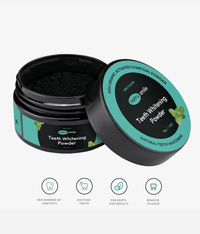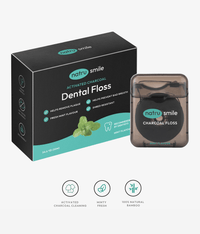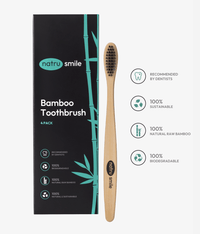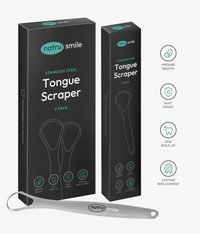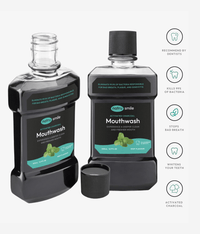
All products are certified by dental expert Dr. Greg Grillo
Maintaining good oral health is essential for an individual's overall well-being, and understanding the role of biofilm in the mouth is crucial for preventing dental issues. In this detailed and expansive guide, we will discuss the concept of biofilm, delve into its formation stages, and provide valuable advice on how to safeguard your mouth from potential harm caused by harmful bacteria.
Understanding Biofilm: What Is It?
A biofilm is a thin layer of microorganisms that forms on a surface, in this case, your teeth, gums, and other oral tissues. These microorganisms produce an extracellular matrix (a slimy substance) primarily consisting of polysaccharides, which help the microbes adhere to surfaces and protect them from the external environment. Biofilms in the mouth contribute to dental concerns such as tooth decay, gum disease, and bad breath.
Formation Stages Of Biofilm
The formation of dental biofilm goes through several stages, as outlined below:
-
Formation Of The Acquired Pellicle: Saliva coats the surface of the teeth, creating a thin, protective layer called the acquired pellicle. This film is essential for the initial attachment of bacteria.
-
Initial Bacterial Attachment: The acquired pellicle enables oral bacteria to attach to the tooth surfaces through specific adhesion mechanisms.
-
Formation Of Microcolonies: As oral bacteria multiply, conglomerates of bacterial cells begin to form. These clusters lead to the development of microcolonies, which eventually grow into mature biofilms.
-
Biofilm Maturation: Over time, the bacterial microcolonies develop a complex architecture and become firmly attached, leading to the formation of a mature biofilm.
- Biofilm Detachment: Bacterial cells or small clusters break off from the mature biofilm and disperse in the mouth, leading to the colonization of new tooth surfaces.
Risks Associated With Biofilm
If not removed through proper oral hygiene practices, dental biofilm is harmful and leads to various oral health issues, such as:
- Tooth decay and cavities
- Gum disease (gingivitis and periodontitis)
- Bad breath (halitosis)
- Stained teeth
How To Protect Your Mouth From Harmful Bacteria
To prevent dental issues related to biofilm, it is essential to adopt an effective oral hygiene routine. Here are some steps you can take to protect your mouth:
-
Brush Your Teeth: Brush your teeth for at least two minutes twice a day, using a soft-bristled toothbrush and fluoride toothpaste.
-
Floss Daily: Flossing helps remove food debris and bacteria from areas that your toothbrush cannot reach.
-
Rinse With Mouthwash: Using an antimicrobial mouth rinse helps with controlling the buildup of dental biofilm.
-
Maintain A Healthy Diet: Limit the consumption of sugary and acidic foods, which contributes to dental biofilm formation.
- Stay Hydrated: Drinking water regularly helps in washing away food debris and bacteria, thus preventing the formation of biofilm.
The Importance Of Professional Dental Cleanings
In addition to following a proper at-home oral hygiene routine, it is essential to visit a dental professional for regular checkups and cleanings. Professional dental cleanings help remove any stubborn biofilm or tartar deposits that may have formed on your teeth and gums. Regular dental visits also allow your dentist to monitor your oral health and address any issues before they become severe.
Keeping your mouth protected from harmful bacteria is crucial to maintaining good oral health. By understanding the formation and dangers of biofilm and following the steps outlined in this guide, you can effectively reduce the risks associated with dental biofilm and enjoy a healthier, happier smile.
What’s Inside Biofilm?
Biofilms are intricate, organized communities of microorganisms, like bacteria, fungi, and algae, that form on both living and non-living surfaces. These microbial colonies stick to a surface by producing a glue-like substance known as extracellular polymeric substances (EPS). EPS is composed of polysaccharides, proteins, nucleic acids, and lipids, which together help create a slimy film that offers protection, nourishment, and structural support to the microorganisms within the biofilm.
The phenomenon of biofilm formation is widespread and observed on various surfaces, ranging from natural environments to man-made objects. For instance, biofilms are commonly found in soil, on rocks, and in water bodies. They also develop on objects like pipes, industrial machinery, and medical devices such as catheters, dental implants, and artificial heart valves.
However, one of the most relevant surfaces for human health is the formation of biofilm within the human body. In the context of oral health, the development of a biofilm, better known as dental plaque, is a primary concern. Dental plaque is a prime example of biofilm formation on teeth, and its existence is the culprit of various dental issues, including cavities, gingivitis, and periodontal disease. Hence, understanding biofilms is pivotal for maintaining good oral hygiene and preventing potential dental health problems.
Stages Of Biofilm Formation
The process of biofilm formation is a complex, multi-step phenomenon that is broken down into three primary stages. In this section, we will discuss the planktonic phase, biofilm phase, and dispersion phase in detail to provide a better understanding of the intricate factors involved in biofilm development.
Planktonic Phase
The planktonic phase is the first stage of biofilm formation, marked by the presence of individual bacterial cells, referred to as planktonic bacteria. These bacteria are free-floating within a liquid environment, such as saliva, and utilize various mechanisms to move around. Examples of these movement mechanisms include structures like flagella, whip-like appendages, and pili, hair-like projections extending from the cell surface. Planktonic bacteria are found in diverse environments, including the oral cavity, where they potentially contribute to dental problems.
Biofilm Phase
During the biofilm phase, planktonic bacteria adhere to surfaces by producing a glue-like substance called extracellular polymeric substances (EPS). Once attached, these bacterial cells multiply and begin to form micro-colonies. Over time, the micro-colonies grow into a mature biofilm structure, which is essentially a community of bacteria embedded within the protective matrix of EPS.
The biofilm phase serves a crucial role in bacterial survival, as it safeguards the bacteria from the host's immune system and antimicrobial agents. This protective function renders the bacteria more resistant to conventional treatments, presenting challenges in effectively eliminating the biofilm-related infection.
Dispersion Phase
The final stage in the biofilm formation process is the dispersion phase, during which some bacterial cells detach from the biofilm matrix and revert to their planktonic state. This detachment enables the bacteria to spread to new locations, where they initiate the biofilm formation process once again, potentially causing further infection or contamination.
The dispersion phase also presents difficulties in controlling bacterial growth and colonization, as the dispersed bacteria continuously form new biofilm structures, leading to chronic or recurring infections in the affected areas.
How Does Biofilm Form In Our Mouths?
Various factors contribute to the formation of biofilm in our mouths. To understand this process, let's first define what biofilm is. A biofilm is essentially a collection of microorganisms, such as bacteria, that adhere to surfaces and produce a slimy film. They are complex and dynamic structures, often resistant to antimicrobial agents, which makes them challenging to treat.
The oral cavity is an ideal environment for biofilm formation, as it is a moist and warm space that provides a perfect breeding ground for bacteria that cause these dental biofilms. In the sections below, we will discuss the major factors that promote biofilm formation in our mouths.
Oral Hygiene And Biofilm Formation
One of the primary factors that contribute to biofilm formation is poor oral hygiene. When we don't clean our mouths regularly and thoroughly, oral bacteria accumulate and eventually form biofilms on teeth surfaces. This buildup leads to a variety of dental problems, such as cavities, gum disease, and bad breath.
What we eat and drink also significantly impacts the formation of biofilm in our mouths. The consumption of sugary foods and beverages provides a plentiful source of energy for oral bacteria to thrive. As these bacteria metabolize sugars, they produce acids that lead to enamel demineralization and contribute to tooth decay. Limiting your sugar intake and making healthier food choices help reduce the likelihood of biofilm formation.
Effects Of Smoking On Biofilm Formation
Smoking has been shown to contribute to the buildup of dental biofilm, as it alters the oral environment, allows harmful bacteria to flourish, and hinders the body's natural defense mechanisms. This results in a higher risk of gum disease, tooth decay, and other oral health issues associated with biofilm formation.
Imbalance Of Oral Bacteria
Our mouths contain a diverse range of bacteria, both helpful and harmful. When there is an imbalance in this oral microbiome, harmful bacteria start dominating, leading to the development of biofilms on teeth and gum surfaces.
In conclusion, numerous factors contribute to the formation of biofilm in our mouths, including poor oral hygiene, dietary choices, smoking, and an imbalance in oral bacteria. By addressing these factors and maintaining a consistent oral care routine, we help prevent biofilm formation and maintain optimal oral health.
How To Remove Dental Biofilm For Optimal Oral Health
The removal of dental biofilm is an integral aspect of maintaining good oral health. Dental biofilm, a sticky layer of bacteria that forms on teeth, leads to various dental issues if not adequately managed. In this section, we'll explore four essential methods to effectively remove biofilm from your mouth and minimize the risk of dental problems.
Brushing
Regular brushing is crucial in preventing and removing biofilm in the mouth. It is important to brush your teeth at least twice a day using a soft-bristled toothbrush and fluoride toothpaste, focusing on all tooth surfaces – including the outer, inner, and chewing surfaces. Hold your toothbrush at a 45-degree angle and use gentle, circular strokes for optimal cleaning. Additionally, make sure to replace your toothbrush every 3-4 months, or when the bristles show signs of wear, to ensure effective cleaning.
Flossing
Flossing is an essential step in meticulous oral hygiene, as it helps to remove food particles and biofilm stuck between teeth, areas that are difficult to reach with a toothbrush. Experts recommend flossing at least once a day, preferably before bedtime, to clean tight spaces between teeth and prevent the build-up of bacteria. When flossing, use a gentle sawing motion and curve the floss around each tooth to ensure effective cleaning.
Cleaning Orthodontic Devices
If you have dental appliances such as braces or retainers, it's crucial to clean them regularly to prevent the accumulation of biofilm on the devices. Make sure to follow your dentist's advice on how to clean and maintain your specific dental appliance. Some tips for cleaning orthodontic devices include using a toothbrush with a smaller head to reach tight spaces and using specialized cleaning tools and solutions for braces and removable retainers.
Browse Products To Remove Biofilm
You should also consider using specially designed products that target the removal of dental biofilm, such as antimicrobial toothpaste, mouthwashes, and tongue cleaners. Antimicrobial toothpaste, for example, contains bacteria-fighting agents that help with reducing biofilm accumulation on teeth. Meanwhile, alcohol-free mouthwashes assist in flushing away lingering biofilm and food debris after brushing and flossing. Finally, tongue cleaners are valuable tools in combatting biofilm build-up on the tongue, which is often overlooked during regular oral care routines.
By incorporating these methods into your daily oral care routine, you can effectively remove dental biofilm and maintain optimal oral health, helping to reduce the risk of dental issues caused by the accumulation of bacteria on your teeth.
How Do You Prevent Biofilm In The Mouth?
Preventing biofilm buildup in the mouth is essential for maintaining healthy teeth and gums. A key element to achieving this is a consistent and comprehensive oral hygiene routine. In this section, we'll offer detailed advice on different ways you can prevent biofilm formation.
Proper Oral Hygiene
Adopting a consistent and thorough oral hygiene routine is one of the best ways to prevent biofilm buildup. Good oral hygiene should include:
-
Brushing: Brush your teeth twice a day for at least two minutes using fluoride toothpaste. Ensure to clean all surfaces of your teeth, gums, and tongue to remove food particles and bacteria.
-
Flossing: Floss at least once daily to remove debris and bacteria trapped between your teeth, where your toothbrush may not reach.
- Mouthwash: Use an antibacterial mouthwash to reduce bacteria levels in your mouth and improve overall oral health. Remember, mouthwash is not a substitute for brushing and flossing but a supplement to your daily routine.
Healthy Diet
Eating a healthy diet with minimal sugary foods is another powerful way to prevent biofilm formation. Excess sugar acts as a catalyst for bacterial growth and contributes to plaque buildup. To promote good dental health, you should:
- Limit the consumption of sugary snacks and drinks.
- Incorporate more fruits, vegetables, and whole grains into your diet.
- Choose water over soda or sports drinks to stay hydrated.
Avoid Tobacco Products
Tobacco products, such as cigarettes and smokeless tobacco, increase the risk of biofilm formation in the mouth. Quitting tobacco significantly lowers the risk of dental issues and improves overall oral health.
Regular Dental Checkups
Attending regular dental checkups every six months for professional cleaning is crucial for maintaining a healthy mouth. Dental professionals can identify and remove stubborn biofilm, tartar, and plaque that your daily oral hygiene routine may not eliminate. Regular checkups also offer an opportunity for your dental professional to examine your teeth and gums for potential problems, allowing early intervention if needed.
By combining proper oral hygiene, a healthy diet, avoiding tobacco products, and attending regular dental checkups, you prevent biofilm buildup in your mouth and enjoy a healthier, cleaner smile.
Is Biofilm Harmful?
The bacteria found within dental biofilm are mostly harmless when they remain on the surface of teeth and gums. However, when the biofilm accumulates and thickens, it becomes a breeding ground for harmful bacteria that lead to cavities, gum disease, bad breath, and tooth loss.
What Causes Biofilm In The Mouth?
The formation of dental biofilm begins with saliva containing food particles, minerals, and proteins. These substances provide nutrients for bacteria to grow in the mouth. As these bacteria multiply they release sticky substances called extracellular polymeric substances (EPS). The EPS allows them to stick together forming a matrix that traps the bacteria and other substances in a thin film. This biofilm accumulates on teeth, gums, and other surfaces of the mouth such as dentures, bridges, and crowns.
Biofilm formation is driven by bacterial adhesion to surfaces but it is also encouraged by plaque or calculus from food particles. The bacteria interact with saliva proteins which create an environment for them to thrive. In addition, poor oral hygiene habits like inadequate brushing or flossing lead to more biofilm accumulation as well as an increased risk of tooth decay and gum disease.
Is Biofilm In The Mouth Normal?
The main components of dental biofilm are bacteria from food particles that accumulate between teeth and gums along with saliva and mucus. Biofilm also contains other microorganisms such as fungi, protozoa, and viruses. It is a normal part of bacterial ecology in the mouth and plays an important role in oral health by helping to protect teeth and gums from harmful bacteria.
What Are The Symptoms Of Biofilm?
The most common symptom of biofilm is bad breath. This happens because bacteria in the biofilm produce sulfur-containing compounds which have an unpleasant smell. Bad breath is also caused by poor oral hygiene or certain foods like garlic and onions that are rich in sulfur-producing compounds.
Another symptom associated with biofilm is redness, swelling, and bleeding of the gums. This occurs when plaque builds up on teeth, irritates the gums, and causes inflammation. The gum tissue may become tender and painful to the touch, leading to discomfort when eating or brushing your teeth.
In addition to bad breath and gum problems, biofilm also leads to tooth decay. Bacteria in biofilms produce acids that wear away the enamel on teeth leading to cavities. Cavities are permanent damage that needs treatment by a dentist before they cause further problems such as pain or infection.
Finally, biofilms also increase the risk for more serious dental issues such as gum disease. When plaque accumulates under the gums, it causes inflammation and infection in the area leading to gingivitis or periodontal disease. These conditions lead to tooth loss if not treated properly.
What Foods Break Down Biofilm?
Some of the best foods for breaking down biofilm are:
- Fermented foods (kimchi, sauerkraut, yogurt, etc.)
- Coconut oil
- Apple cider vinegar
- Green tea
- Aloe vera
- Parsley
- Garlic
- Xylitol
All of these foods are high in enzymes and antimicrobial compounds that help to break down biofilm.
What Happens If Biofilm Is Not Removed?
When dental plaque builds up, it hardens into tartar or calculus. This hardened plaque forms an impenetrable layer around the teeth that traps further bacteria and makes it difficult for the teeth to be cleaned properly. Bacteria that are trapped in calculus produce toxins that cause tooth decay and gum disease. As the plaque continues to build up, the risk of developing cavities or periodontal disease increases significantly.
If dental biofilm is not removed regularly through brushing, flossing, and professional dental cleanings, it leads to more serious health conditions. Gum disease is the main result, which has been linked to an increased risk of stroke, heart attack, diabetes, and other systemic illnesses.
What Is The Best Mouthwash For Biofilm?
Mouthwashes are great at killing off bacteria in the mouth but some are better than others when it comes to fighting dental biofilm. Generally, mouthwashes that contain anti-microbial agents like chlorhexidine gluconate, essential oils, or cetylpyridinium chloride are effective at controlling biofilm. These ingredients help reduce the number of bacteria in your mouth and make it harder for plaque to stick to your teeth and gums.
Another great option is fluoride mouthwash, which helps prevent cavities by strengthening tooth enamel. Fluoride also works to break up existing bacterial colonies so they can't form dental biofilm as easily. It's important to note that although fluoride does help control plaque it isn't specifically designed for this purpose, so you may want to consider using an additional product for this specific issue.
Can Biofilm Be Cured?
Biofilm is treated through various methods such as brushing your teeth twice a day, flossing regularly, and using an antimicrobial mouth rinse. Brushing removes bacteria and food particles from the teeth while flossing helps to remove plaque between the teeth where brushing may not reach. An antimicrobial mouth rinse helps kill any remaining bacteria that brushing and flossing missed.
It’s also important to make sure your dental hygiene habits are effective in preventing biofilm buildup. This includes replacing your toothbrush every three months or after you’ve been sick with a cold or flu virus, limiting sugary snacks and drinks, visiting your dentist for regular cleanings, avoiding smoking or using chewing tobacco, and drinking plenty of water.
For those with more severe cases of biofilm buildup, there are a few more aggressive treatment options that may be recommended such as scaling and root planing (deep cleaning) or laser therapy. These treatments are performed by a dentist or dental hygienist to remove the bacteria from below the gumline. If left untreated, biofilm leads to periodontal disease, which is an infection in the gums that affects both oral hygiene and overall health if it’s not addressed quickly enough.
Does Salt Destroy Biofilm?
The answer is yes! Salt has been proven effective at disrupting the formation of biofilm by weakening the bonds between bacterial cells. Studies have shown that applying a salt solution to the surface of teeth reduces the amount of biofilm, which is a major contributor to dental decay and periodontal disease.
Can You Starve Biofilm?
The key to controlling biofilm lies in understanding how it feeds. Biofilms feed off sugar and carbohydrates that are present in the mouth. Therefore, reducing your intake of sugary snacks and drinks will reduce the amount of food for the bacteria to use. Additionally, brushing regularly with an anti-bacterial toothpaste, flossing twice a day, and using mouthwash helps starve the biofilm.
How Do You Break Biofilm Bacteria?
To break down the biofilm bacteria on your teeth, you need to remove it mechanically or with chemical agents. Brushing regularly is one way to remove biofilm from your teeth mechanically. A powered toothbrush will help you reach all areas of your mouth more effectively than manual brushing alone, as it has a higher frequency of rotation which helps loosen food particles stuck in between the teeth and removes biofilm buildup.
In addition to brushing, you can also use chemical agents to break down the bacteria in biofilm. Antimicrobial mouthwashes containing ingredients like hydrogen peroxide or chlorine dioxide are effective at breaking down plaque and killing the bacteria that cause it. You may need multiple applications of these products over time to reduce the amount of plaque on your teeth.
Can Biofilm Cause Infections?
When biofilm builds up on your teeth it is known as dental plaque. Plaque is made up of bacteria, food particles, and other substances that build up on the teeth. It is difficult to remove because it sticks to the tooth surface, creating a sticky film. The bacteria in plaque produce acids as they feed off of sugars found in food and drinks. These acids cause cavities by eating away at the enamel on your teeth, leading to decay and infection if left untreated.
The presence of dental biofilm also increases your risk of developing gum disease, or periodontal disease. This serious condition occurs when infections set into the gums around your teeth due to inflammation from bacterial plaque. Symptoms of gum disease include red, swollen, and tender gums that bleed easily when brushing or flossing. If left untreated, the infection spreads deeper into tissues and bones surrounding your teeth, leading to tooth loss.
Understanding Biofilm And Preventative Oral Health Maintenance Is Crucial
In conclusion, grasping the fundamental concept of biofilm formation in the mouth and the different techniques to impede its development is of paramount importance for preserving excellent oral health. A combination of effective dental hygiene practices, a nutritious diet, and an overall healthy lifestyle contributes significantly to the maintenance of a pristine oral environment.
A more in-depth understanding of what biofilm is, the challenges it presents, and the ways we can combat it will empower you to take better care of your teeth and gums. Moreover, being well-informed about various dental issues, such as black dots on teeth, allows you to seek timely professional advice and treatment, thereby minimizing potential complications and further damage to your dental structure.
Consistent proper dental hygiene practices, which include brushing at least twice a day, flossing daily, and rinsing with an appropriate mouthwash, help to remove plaque and tartar buildup that contribute to the manifestation of black dots on teeth. Additionally, regular dental check-ups, ideally every six months or as advised by your dental practitioner, play a crucial role in the early detection and treatment of any dental concerns.
By adopting wholesome and balanced dietary habits, limiting sugary and acidic food and beverages, and getting sufficient vitamins and minerals, you bolster your oral health and bolster the teeth's resilience against decay and damage.


